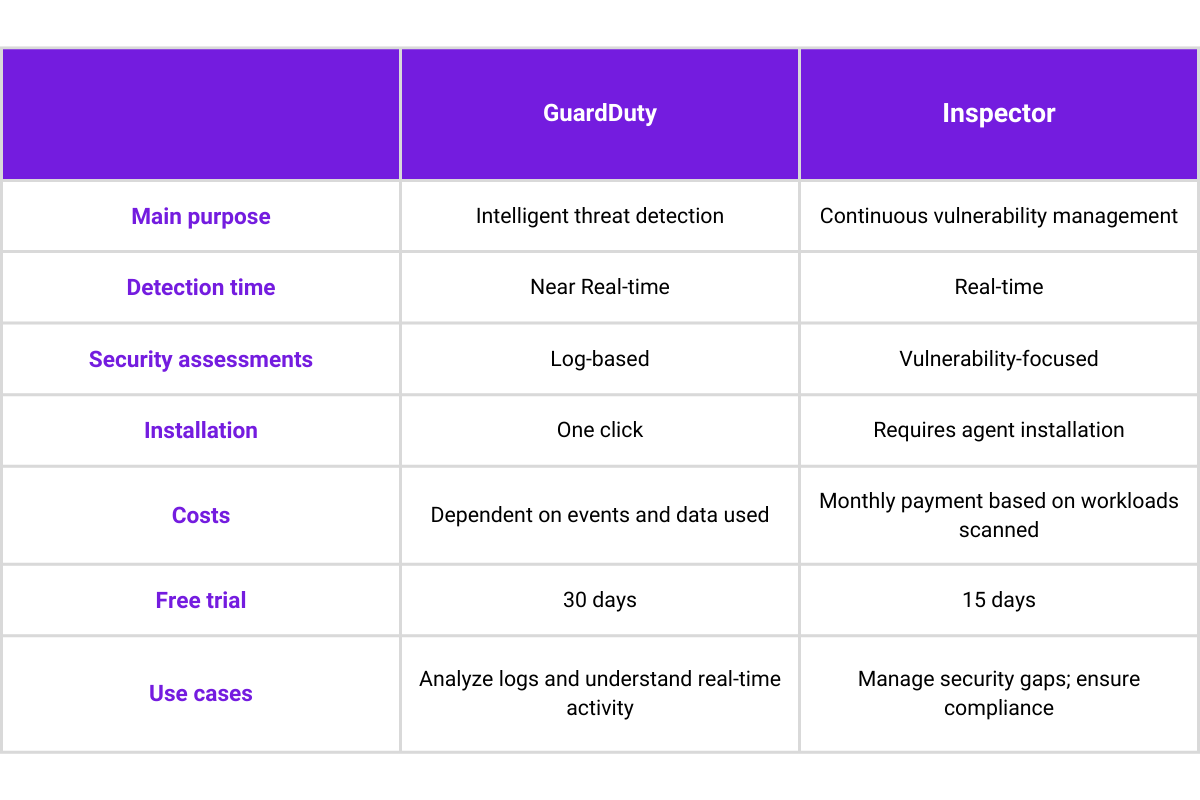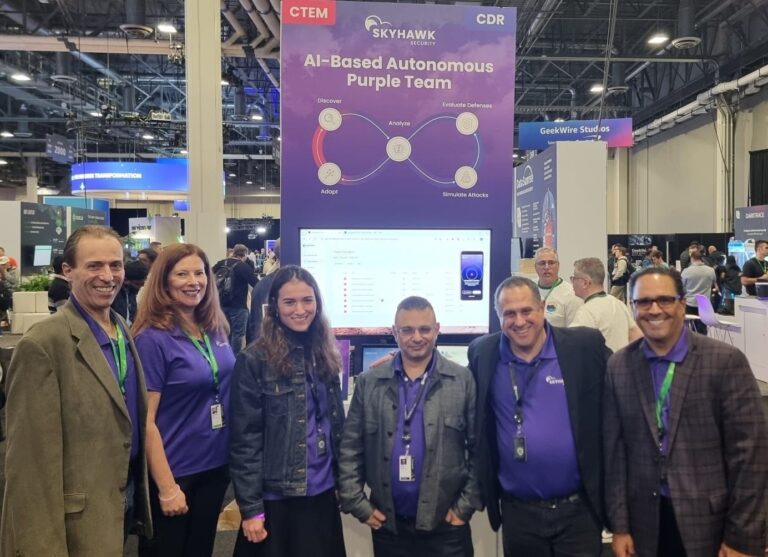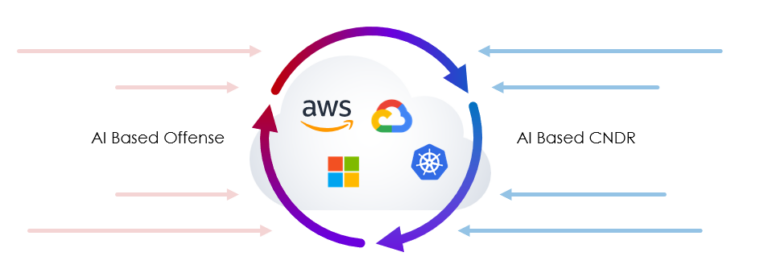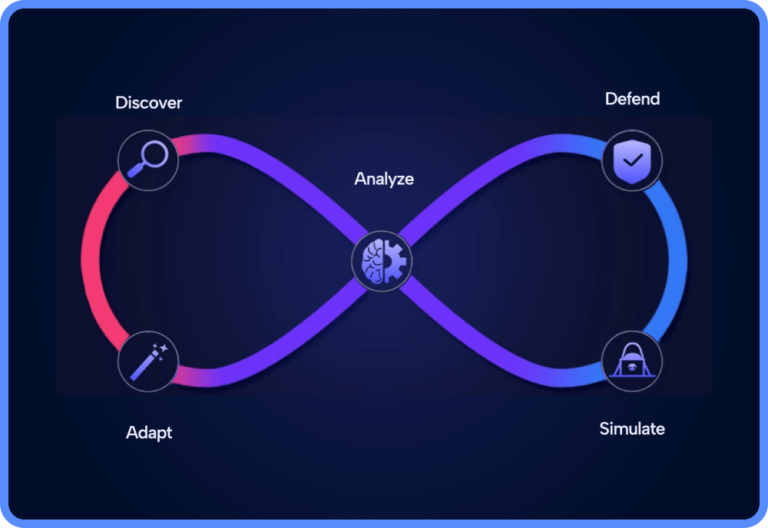There is never a dull moment in the world of cyber attackers. From misconfigurations to data misuse, the possibilities are endless for hackers to get into your cloud systems, making threat detection tools indispensable for any company.
Over the past year, 80% of cloud users suffered a severe security incident. As cloud security concerns rise and cyber-attack consequences become more impactful, cloud providers rush to offer their customers increasingly more advanced security scanning tools.
As the leader in the cloud provider space, AWS offers many security solutions to monitor AWS environments and detect threats before they become a corporate nightmare. Two of the most popular security monitoring and scanning tools are GuardDuty and Inspector. This article gives you a round-up of these tools’ features and their benefits and drawbacks.
What is AWS GuardDuty?
AWS GuardDuty is an intelligent threat detector service that continuously monitors your entire AWS environment, including databases, Amazon S3, and container workloads. Aside from giving you a holistic overview of activity in your environment, it leverages capabilities such as machine learning to detect security issues such as compromised credentials or unauthorized access in real-time. You can integrate it with other AWS tools, such as AWS Security Hub, Amazon Detective, and AWS Lambda, to perform more thorough security investigations and automate remediation.
The Benefits and Drawbacks of GuardDuty
As an AWS user, you can easily and quickly integrate AWS GuardDuty into your environment. After the set-up, GuardDuty proactively monitors incoming and outgoing connections from your AWS resources to malicious resources.
It offers a holistic view across multiple accounts and large environments and detects threats your team might have missed because there’s so much data to process. When a security issue comes up, GuardDuty alerts you and helps you respond faster. Combining this speed and depth of data, you’re much likelier to prevent threat escalation and security breaches.
That said, GuardDuty’s security scope is broad enough to cover unusual activity that may well be coming from your team or users (aka not a security threat). Because it doesn’t analyze events’ sequences, it will alert you every time there is any remotely unusual action – giving way for false positives to show up at your SOC team’s desk. 50% of companies receive more than 500 cloud security alerts per day. While they’re busy investigating false positives, they may miss out on resolving actual attacks on time.
What is AWS Inspector?
AWS Inspector scans your AWS workloads regularly to detect and manage unintended network exposure and software vulnerabilities across Amazon EC2 (Amazon Elastic Compute Cloud), Amazon ECR (Amazon Elastic Container Registry), and AWS Lambda.
It scores your specific environment based on its behavior and history and brings up critical findings to help you understand your security posture. When your score is down, you know there might be an issue. When your findings indicate risk, you get actionable solution suggestions to help you transition back to safety.
AWS Inspector integrates with Amazon ECR so you can scan container images to check for operating system vulnerabilities. You can also integrate with AWS Security Hub to review how your security efforts align with industry best practices and standards.
The Benefits and Drawbacks of AWS Inspector
AWS Inspector identifies misconfigurations and vulnerabilities and tells you where they’re located and how severe they are. It enables you to assess how compliant your Amazon EC2 is with critical regulations such as HIPAA, SOC, and PCI. Significantly, it simplifies your operational strategy by letting you know what’s vital to do first. Then, it offers proactive actions you can take to ensure these issues don’t escalate further.
However, if you go with AWS Inspector, you’ll need to install both the AWS Systems Manager and the SSM Agent (or activate them if they’ve been pre-installed). AWS Inspector uses these tools to collect your EC2 data and then scans it for vulnerabilities. While installing agents in these cases is expected, look into how many resources it requires to maintain these.
AWS GuardDuty vs. Inspector: Feature Comparison
Threat Detection Capabilities
The faster you discover potential and actual threats, the quicker you can take action, and the bigger your chances to protect your organization, employees, and customers. GuardDuty analyzes your network activity in near real-time. After being rearchitected in late 2021, Inspector offers real-time automated vulnerability management.
Automate Security Assessments
When you’re in charge of your organization’s network security, you must always be on top of its vulnerability status. GuardDuty offers log-based assessments of behaviors across your accounts and workloads. Inspector’s focus is vulnerability assessments of the systems you run on the AWS network. It assesses both applications and hosts.
Ease of Use
GuardDuty only takes a few clicks to step up; you don’t need to install it. It’s easy to use yet only operates within specific rules, so you might miss important events that don’t align with them. Plus, you might get your fair share of false positives. Setting up Inspector requires installing an agent, defining roles, and tagging assets, but it’s slightly more complex. You can also customize benchmarks, an added step in the configuration process.
Cost Structure
With GuardDuty, you get charged based on how many events and how much data got analyzed. Inspector, on the other hand, requires a monthly payment based on the workloads that got scanned. You can calculate pricing for GuardDuty and Inspector to estimate how much you will pay. Plus, both tools offer a free trial.
Use Cases
The AWS GuardDuty vs. Inspector debate comes down to what each is best for and whether that specialty supports your needs. GuardDuty can help assist in security investigations and make the remediation process faster and easier – ideal for busy DevOps teams. Inspector can be particularly useful for regulatory-heavy industries because it offers ongoing vulnerability monitoring and assessments across EC2 and ECR.
Securing your AWS environment
Both GuardDuty and Inspector are sought-after for a reason: they play an essential role in protecting your AWS accounts. Using these tools simultaneously can help ensure you have augmented security monitoring AND detailed information about your vulnerabilities and how to mitigate them. After all, the more information you have about what’s going on in your systems, the more protected you are and the more proactive you can be.
If you want to gain 360-degree visibility across all your cloud resources and robust threat detection capabilities, Skyhawk Security can complement tools like AWS GuardDuty. Skyhawk takes security monitoring and threat detection a step further by analyzing event sequence and user behavior to determine the severity of each threat and alert you only with real threats.
Find out more about our next-generation threat detection capabilities.







